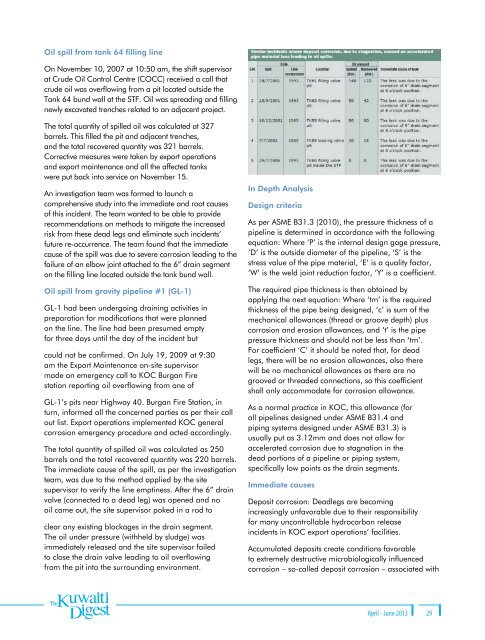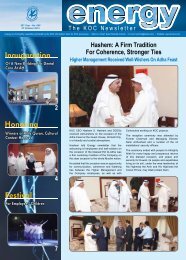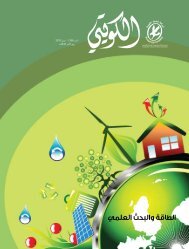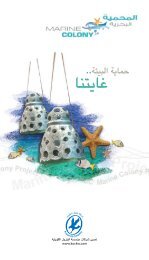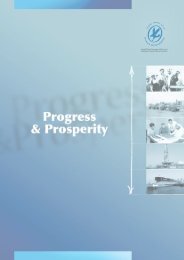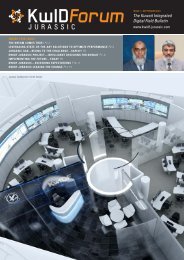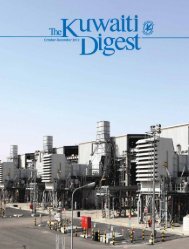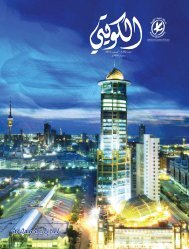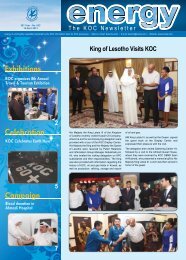6 - Kuwait Oil Company
6 - Kuwait Oil Company
6 - Kuwait Oil Company
Create successful ePaper yourself
Turn your PDF publications into a flip-book with our unique Google optimized e-Paper software.
<strong>Oil</strong> spill from tank 64 filling line<br />
On November 10, 2007 at 10:50 am, the shift supervisor<br />
at Crude <strong>Oil</strong> Control Centre (COCC) received a call that<br />
crude oil was overflowing from a pit located outside the<br />
Tank 64 bund wall at the STF. <strong>Oil</strong> was spreading and filling<br />
newly excavated trenches related to an adjacent project.<br />
The total quantity of spilled oil was calculated at 327<br />
barrels. This filled the pit and adjacent trenches,<br />
and the total recovered quantity was 321 barrels.<br />
Corrective measures were taken by export operations<br />
and export maintenance and all the affected tanks<br />
were put back into service on November 15.<br />
An investigation team was formed to launch a<br />
comprehensive study into the immediate and root causes<br />
of this incident. The team wanted to be able to provide<br />
recommendations on methods to mitigate the increased<br />
risk from these dead legs and eliminate such incidents’<br />
future re-occurrence. The team found that the immediate<br />
cause of the spill was due to severe corrosion leading to the<br />
failure of an elbow joint attached to the 6” drain segment<br />
on the filling line located outside the tank bund wall.<br />
<strong>Oil</strong> spill from gravity pipeline #1 (GL-1)<br />
GL-1 had been undergoing draining activities in<br />
preparation for modifications that were planned<br />
on the line. The line had been presumed empty<br />
for three days until the day of the incident but<br />
could not be confirmed. On July 19, 2009 at 9:30<br />
am the Export Maintenance on-site supervisor<br />
made an emergency call to KOC Burgan Fire<br />
station reporting oil overflowing from one of<br />
GL-1’s pits near Highway 40. Burgan Fire Station, in<br />
turn, informed all the concerned parties as per their call<br />
out list. Export operations implemented KOC general<br />
corrosion emergency procedure and acted accordingly.<br />
The total quantity of spilled oil was calculated as 250<br />
barrels and the total recovered quantity was 220 barrels.<br />
The immediate cause of the spill, as per the investigation<br />
team, was due to the method applied by the site<br />
supervisor to verify the line emptiness. After the 6” drain<br />
valve (connected to a dead leg) was opened and no<br />
oil came out, the site supervisor poked in a rod to<br />
clear any existing blockages in the drain segment.<br />
The oil under pressure (withheld by sludge) was<br />
immediately released and the site supervisor failed<br />
to close the drain valve leading to oil overflowing<br />
from the pit into the surrounding environment.<br />
In Depth Analysis<br />
Design criteria<br />
As per ASME B31.3 (2010), the pressure thickness of a<br />
pipeline is determined in accordance with the following<br />
equation: Where ‘P’ is the internal design gage pressure,<br />
‘D’ is the outside diameter of the pipeline, ‘S’ is the<br />
stress value of the pipe material, ‘E’ is a quality factor,<br />
‘W’ is the weld joint reduction factor, ‘Y’ is a coefficient.<br />
The required pipe thickness is then obtained by<br />
applying the next equation: Where ‘tm’ is the required<br />
thickness of the pipe being designed, ‘c’ is sum of the<br />
mechanical allowances (thread or groove depth) plus<br />
corrosion and erosion allowances, and ‘t’ is the pipe<br />
pressure thickness and should not be less than ‘tm’.<br />
For coefficient ‘C’ it should be noted that, for dead<br />
legs, there will be no erosion allowances, also there<br />
will be no mechanical allowances as there are no<br />
grooved or threaded connections, so this coefficient<br />
shall only accommodate for corrosion allowance.<br />
As a normal practice in KOC, this allowance (for<br />
all pipelines designed under ASME B31.4 and<br />
piping systems designed under ASME B31.3) is<br />
usually put as 3.12mm and does not allow for<br />
accelerated corrosion due to stagnation in the<br />
dead portions of a pipeline or piping system,<br />
specifically low points as the drain segments.<br />
Immediate causes<br />
Deposit corrosion: Deadlegs are becoming<br />
increasingly unfavorable due to their responsibility<br />
for many uncontrollable hydrocarbon release<br />
incidents in KOC export operations’ facilities.<br />
Accumulated deposits create conditions favorable<br />
to extremely destructive microbiologically influenced<br />
corrosion – so-called deposit corrosion – associated with<br />
April - June 2013 29


